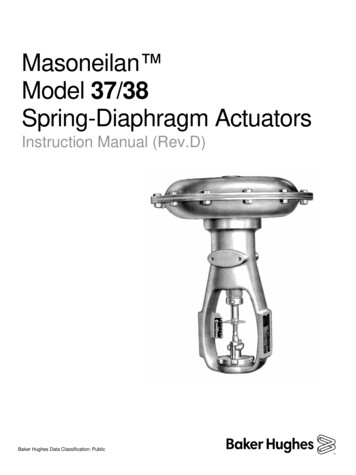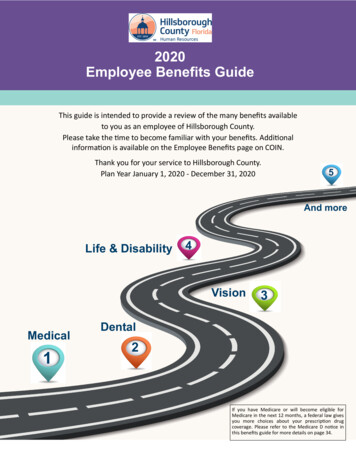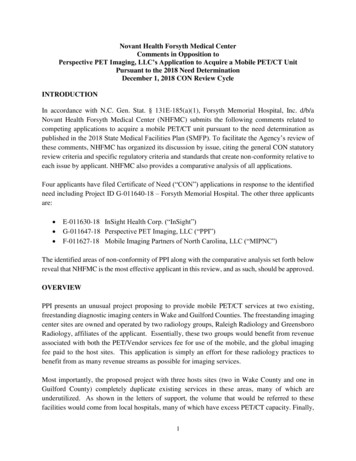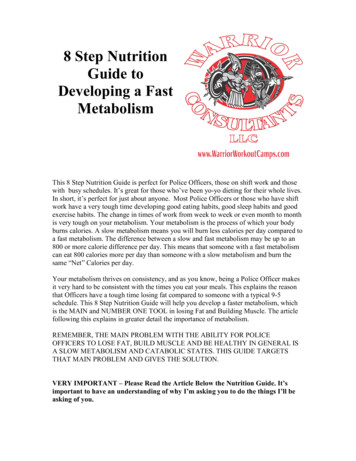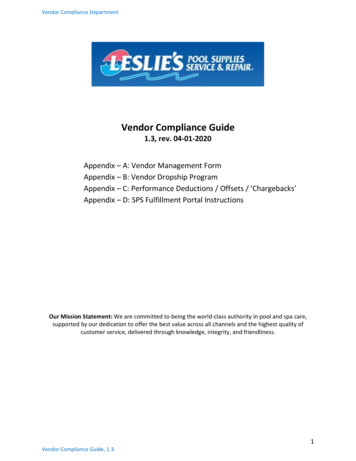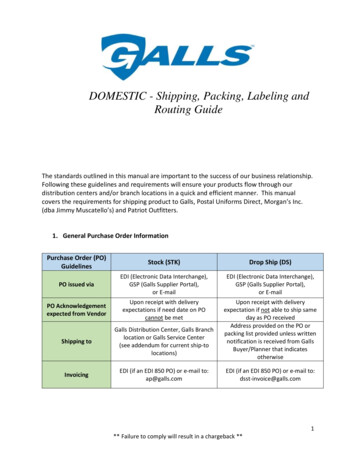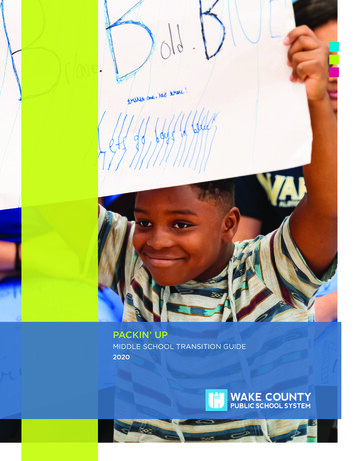
Transcription
PACKIN’ UPMIDDLE SCHOOL TRANSITION GUIDE2020
Dear Counselors and Parents,The transition from elementary to middle school is often an exciting, yet nerve- racking time for students. Bestcase scenario would be that each rising 6th grader feels prepared to enter middle school. As educators orparents, we can greatly enhance students‘ comfort level with this change by exposing them to commonconcerns that arise in middle school and equipping them with skills necessary to be successful. Packin‘ Up:Middle School Transition Guide is created in an effort to support 5th grade counselors, 6th grade counselors andparents in this endeavor. The information within this guide can be used by counselors and parents at theelementary and middle school levels; therefore, it can be tailored to the school‘s goals and students‘ needs.Sincerely,The Transition Guide TeamBecky Rackley, Counselor, Holly Ridge Elementary SchoolSue Edwards, Counselor, Lacy Elementary SchoolWhitney Bennett, Counselor, York Elementary SchoolErin Wright, Counselor, West Millbrook Middle SchoolJavier Martinez, Counselor, Ligon Middle SchoolBrent Sauls, Counselor, Daniels Middle SchoolElaine Harper, Counselor, Wakefield Middle SchoolRevised: February 2020 by Kinea Epps, Rolesville Middle School2
TABLE OF CONTENTSGENERAL INFORMATION .5Who’s Who in the Middle School? . 5Glossary of Middle School Terms .6ACADEMICS.10Letter Grading (Middle School). 10Standards-based Grading vs. Letter Grading . 10Honor Roll Recognition .11Homework Requirements .11Time Management/Study Habits.11Description of Core Classes.12Elective Courses .13SOCIAL . 15Problem-solving, Making Good Choices, and Responsibility.15Interactions with Older Students. 16EXTRACURRICULAR ACTIVITIES/GETTING INVOLVED. 18Sports . 18Clubs . 18Music/Band/Drama . 18REGISTERING FOR MIDDLE SCHOOL. 20Registration Information . 20Communicating with Middle School Counselors . 20Making Information Accessible .21Transition Programs.21TIPS FOR MIDDLE SCHOOL PARENTS . 23STAY CONNECTED. 25Powerschool Parent Portal.25Other Online Communication Tools .25SCHOOL COUNSELOR ACTIVITIES . 27Activity 1: Who’s Who in the Middle School?.27Activity 2: Middle School Website Scavenger Hunt. 29Activity 3: The Incredible Power of the Zero. 30Activity 4: The 5 W’s of Study Habits.32Activity 5: Clumps.33Activity 6: A Unit on Middle School Transition .33Activity 7: Transitional Camp Overview.35RESOURCES . 37Academic Resources .37Middle School Websites .37Mental Health and Social Emotional Websites.373
GENERAL INFORMATION
GENERAL INFORMATIONThe transition to middle school can be challenging for students due to differences in middle and elementaryschool settings. It is important for parents’ transition, as well as their child. One adjustment for parents andstudents is to know that in most cases students have to adjust and know that in most cases, students no longerhave one core teacher, but six or seven. This section will provide general information about the functioning ofthe middle school.Who’s Who in the Middle School?Students may notice when they get to the middle school that there are several adults around, but they are notalways sure what those adults do and who to ask for help.TEAM LEADERThis person is one of the core teachers that schedules conferences, facilitates meetings, and manages theteam‘s activities. He/she is the first point of contact when a student‘s school performance needs to beaddressed.GRADE LEVEL COUNSELOROne very important thing for students to understand is that their middle school counselor is there to help them,just like their elementary counselor. For most middle schools within Wake County, there is one counselor forevery grade level or track, for year-round schools, in middle school. For many schools that counselor rotateswith their students for all three years, but for some the counselors remain in the same grade level from year toyear. The counselor in the middle school will typically not be in the classroom as much as the elementarycounselors but are available for individual and group sessions. The counselor is not an administrator and is notresponsible for disciplinary actions.GRADE LEVEL ADMINISTRATORThe administrative layout of a middle school can be very confusing to some students. They have a principal ofthe whole school, but they will most likely have a grade level administrator (or Assistant Principal). Thestudent’s grade level administrator will more often than not be the one to handle safety, disciplinary, and/orfacility situations within that grade level.GUIDANCE TECHNICIANThere is typically a guidance technician in each of the middle schools. This individual is usually the first person anew student meets at the school because they often handle the initial registration process. The technician alsocoordinates the withdrawal process for students leaving the school.5
CASE MANAGERIt is important to know that students with special needs have been assigned a case manager to help ensure thattheir needs are being met. Special education teachers serve as the case manager for an identified group ofstudents who have an Individualized Educational Program (IEP). These teachers are responsible for ensuringthat the IEP is implemented, scheduling meetings to discuss an IEP, and/or to answer questions regarding theIEP. The 504 Contact is the case manager for students who have a Section 504 Accommodation Plan. In mostmiddle schools, this person is typically a counselor. The AIG Coordinator is the case manager for students whohave a Differentiation Educational Plan (DEP). Finally, the ESL Resource Teacher is the case manager forstudents who have a Limited English Proficiency (LEP) Plan.SCHOOL RESOURCE OFFICER (SRO)The school resource officer is not a security guard, but a Wake County Sheriff's Deputy. His/her presence oncampus can be intimidating if students are unaware of the role the resource officer plays within the school.These individuals are on campus to maintain student safety. Almost all middle schools in the county have one,so it does not mean a school is a tough school for having a full- time resource officer. The school resourceofficers are very approachable and they are another source of help for students. See Activity 1Glossary of Middle School TermsCORE CLASSESAlthough elective choices may vary by individual middle schools, all middle schools require each regulareducation student to take Language Arts, Social Studies, Math, and Science.ADVANCED CLASSESThese classes comprise students who are identified academically intellectually gifted (AIG) and students whohave received recommendations from teachers because they are performing at an extremely high level. Mostmiddle schools offer advanced classes in language arts and math. Advanced classes in other subject areas aremore often available in magnet schools.BINDERSMost teams require an organizational system comprised of binders and/or folders. A 3 ring binder is usuallyrequired and acts as the student‘s desk, the place where he/she keeps most of his/her things for class.AGENDAOne of the most important objects a student will possess in middle school is his/her agenda. The agenda isessentially a planning book in which students can write down homework assignments, upcoming projects, datedactivities, or any other important information. Using an agenda can help students with short-term and long-termgoal-setting and planning. Some schools have agendas available for parents to purchase. Others allow studentsto use their preferred method for keeping up with assignments, etc. Be sure to talk with your students about thethbest method for organization. Because 6graders will have many different classes and teacher expectations tokeep track of, writing everything down is essential.6
DISCIPLINEIt is important that middle school students are aware early of the policies for the county and for the school.Wake County policies can be found in the Parent/Student handbook, and individual school policies can usuallybe found at the front of each student‘s agenda. Students need to understand the differences between theirelementary school rules and the new middle school rules and expectations. Topics such as dress code policyand other common violations should be talked about at length with students. Though specifics cannot beaddressed by the elementary schools on each middle school‘s rules, it is important to begin dialogue aboutsome of the differences.ELECTIVESThese are classes that students take in addition to core classes that allow for variety in their day. Somethexamples of electives may include drama, dance, chorus, or art. In 6grade, most schools require that studentstake a keyboarding class, unless they are in a band, strings, or Reading/Math ALP. Students also take a classentitled Healthful Living, which comprises health education and physical education (PE). Classes can be heldquarterly, semesters or year-long.END OF COURSE (EOC) TESTSThese tests are given to students who take high school level courses such as Algebra or Geometry.INCLUSIONStudents with special needs can have their instruction provided to them in the regular classroom setting. Hence,there is no pull-out for AIG or IEP students from their regular classroom settings. AIG students are typicallyserved in the advanced classes, while IEP students may be instructed in the In Class Resource (ICR) classroomsettings. IEP students may also be served through resource classes that coincide with their specific area of need.LOCKERSStudents in middle school will utilize a locker. Most middle schools provide lockers for the students, but oftenstudents must provide the lock. The students do not need to visit their lockers after every class period. Oftenteachers provide times for students to use their lockers and go to the bathroom. Advise students to get theirlocks over the summer and to practice their combinations. In the fall, homeroom teachers will allow studentstime to practice and will always keep a list of students‘ combinations in case they forget! Teachers will alwayshave a default key to unlock lockers when combinations are forgotten.POSITIVE BEHAVIOR INTERVENTION & SUPPORT ( PBIS) & CHARACTER EDUCATIONSome schools are PBIS schools. This is a program established within the school for teaching and rewardingpositive behavior. Additionally, essential to students’ growth and development, teachers incorporate charactereducation lessons into their classrooms. The following traits are emphasized (courage, good judgment, integrity,kindness, perseverance, respect, responsibility, self-discipline)ON TEAM/OFF TEAMIn most schools, students are considered to be on team if they have lunch with one of their core teachers.Conversely, they are considered off team if they have lunch with an elective teacher or H/PE teacher.7
SUPPLY LISTBy the beginning of the school year, schools provide a list of needed supplies for a student to have by teamand/or elective teachers. Most schools have supply lists posted on their school‘s website.TEAMSIn most middle schools, students will be assigned to a team. The team is traditionally composed of four coreteachers. Some variations may include two teacher teams, where both teachers teach 2 subjects each; or threeteacher teams, where at least one teacher teaches more than one subject. Teaming is an important componentto the middle school concept. Teaming allows the teachers to work together to create interdisciplinary units,which enhances student learning.Teams go on field trips or have team days. Schools try to balance teachers on teams such that teacherpersonalities are diverse. Having a mix of different personalities hopefully ensures that each child can almostalways find at least one teacher on their team with whom they connect. In addition, students are placed onteams in a way that promotes academic and demographic equity.TEAM AREAThis area may also be referred to as Team Hallway or Pod but is the designated area of the school in which thestudent‘s core classes are located. Students will spend the bulk of the school day in their team area.TEAM CONFERENCEParents can request to schedule a conference with their child‘s core teachers to discuss their child‘sperformance and/or express concerns. Teams are great for parents because the parent can contact one teacherand get information to, or from, his or her child‘s whole team of teachers. In most schools, the team leader isresponsible for scheduling the conference. However, counselors can be asked to schedule conferences and/orinvited to attend team conferences. Teachers do like to meet as a team but individual teacher conferences canbe requested and scheduled as well.TRANSITION TIMEThe time between classes is usually very short ranging between 3- 5 minutes. This is plenty of time as long asstudents do not continuously stop in the halls and engage in long conversations with friends. Some schools usea bell system that will inform students when each class ends and when the next one begins, while some schoolsonly use a bell that begins school and another at dismissal. See Activity 28
ACADEMICS
ACADEMICSLetter Grading (Middle School)In middle school, students earn letter grades of A, B, C, D, or F on their report cards. They may also be assigneda grade of "I" for "Incomplete" if, because of an emergency, they do not complete work by the end of thegrading period. The "Incomplete" becomes an "F" if work is not finished by an assigned time. Letter grades havethe following numerical values:A90-100B80-89C70-79D60-69FBelow 60In addition to academic performance requirements, students must meet the requirements of the WCPSSattendance policy. Failure to meet the requirements of the attendance policy may result in failure of a class andgrade retention. See Activity 3Standards-based Grading vs. Letter GradingLetter grades are quite different from standards- based grading. In standards- based grading, students areassessed as being at, above, or below grade level using the 1, 2, 3, 3* or 4 number system. Work habits andconduct grades are separate from the student‘s content proficiency. Students are not given a letter grade forassignments or tests. Rubrics are used to assess whether or not the student is performing at, above, or belowgrade level, and a level number is given. The letter grade system is used to measure how well a student hasmastered a specific objective, rather than being assessed on broad concepts over time. This is often shown in apercentage of the questions that the student got correct. Most sixth- grade teachers use a percentage scale. Forexample, some teachers may use these percentages: homework 15%, class work 15%, quiz 30%, and test 40%.Please understand that a 3 in elementary school does not equate to an A or B on the percentage scale. It isimportant to remember that the best way to determine if a student has mastered a concept is the average ofhis/her test and/or quiz grades.10
Honor Roll RecognitionMost middle schools recognize students who have made the honor roll. An honor roll is a list of students whohave made either all A‘s (the A honor roll) or have made a combination of all A‘s and B‘s (the AB honor roll) ontheir report card during each quarter‘s marking period. Middle school recognitions may include certificates,rewards, names being read on announcements, lists of names in the local newspaper, and/or awardsceremonies.Homework RequirementsHomework at the elementary level is used for skills practice and is an indicator of understanding of concepts. Itis not supposed to be used to determine a student‘s level of proficiency. In middle school, students havehomework to complete every night, presentations to give in class, and big group projects to turn in. It is thethfoundation for future tests. Rising 6graders must understand that they will be held accountable for correctlycompleting homework. Parents should encourage their students to find a homework buddy on their team to askabout assignments and missed work when they are absent. Several middle school teachers have websites thatparents and students can access for assignment information.Time Management/Study HabitsIn middle school, time becomes a precious commodity. Students normally have at least six classes in a schoolday- with six different teachers, six different expectations, and sometimes six different homework assignments!Along with being responsible for all of the above, students must also be responsible for managing time; both atschool and at home. One major academic process that students must fit in to their busy schedules is homeworkwhether completing homework assignments, major projects, or studying for tests. Learning and utilizing studyskills will both qualify and quantify time for a 6th grader. Students should use completed work as a study guidealong with notes from class. When studying ahead, students should review notes each night. See Activity 411
Description of Core ClassesSixth grade students study language arts, mathematics, science, social studies, and healthful living.LANGUAGE ARTSFollowing State Standards for English Language Arts, sixth graders develop skills in reading, writing, speakingand listening, and language through experience with print and digital resources. Students read a wide range oftext, varying in levels of sophistication and purpose. Through print and non-print text, they developcomprehension strategies, vocabulary, as well as high order thinking skills.MATHEMATICSThe Standards for Mathematical Practice rest on important “processes and proficiencies” with longstandingimportance in mathematics education. They describe the characteristics and habits of mind that all studentswho are mathematically proficient should be able to exhibit. The eight Standards for Mathematical Practice are: Make sense of problems and persevere in solving them. Reason abstractly and quantitatively. Construct viable arguments and critique the reasoning of others. Model with mathematics. Use appropriate tools strategically. Attend to precision. Look for and make use of structure. Look for and express regularity in repeated reasoning.SCIENCETraditional laboratory experiences provide opportunities to demonstrate how science is constant, historic,probabilistic, and replicable. Although there are no fixed steps that all scientists follow, scientific investigationsusually involve collections of relevant evidence, the use of logical reasoning, the application of imagination todevise hypotheses, and explanations to make sense of collected evidence. Student engagement in scientificinvestigation provides background for understanding the nature of scientific inquiry.SOCIAL STUDIESStudents in sixth grade will continue to expand the knowledge, skills, and understandings acquired in the fourthand fifth grade studies of North Carolina and the United States by connecting those studies to their first formallook at a study of the world. Sixth graders will focus heavily on the discipline of geography by using the themesof location, place, movement, human-environment interaction, and region to understand the emergence,expansion, and decline of civilizations and societies from the beginning of human existence to the Age ofExploration. For more detailed information, please refer to the Middle School Program Planning V5TG-uokSITOCVznDpNoz/view12
Elective CoursesEach middle school offers a program of electives. Electives are courses that students can choose based on theirinterests. Elective courses may be offered in nine-week, trimester, semester, and/or year-long formats. Electiveofferings vary by school; therefore, each school prepares a registration sheet that lists the electives it will offer.The availability of electives depends on student interest, an appropriate facility, and staffing.HEALTHFUL LIVINGHealthful Living is required for all 6th grade students and includes health education and physical education.These two courses complement each other as students learn how to be healthy and physically active for alifetime. Because our health and physical fitness needs are so different from a generation ago, the nature ofhealthful living is changing. Poor health choices (i.e., use of alcohol and other drugs, poor nutrition, and physicalinactivity) now account for more than 50% of the preventable deaths in the United States.SUPPORT/TUTORING PROGRAMSAcademic support and tutoring opportunities will vary from school to school. After and during school programsmight13
SOCIAL
SOCIALProblem-solving, Making Good Choices, and ResponsibilityIt is important to remember that students‘ first priority in middle school is to learn! That being said, social skillscan greatly enhance their chance of having a positive environment in which to learn. Efforts and choices willdirectly affect grades, opportunities to participate in sports and/or other extracurricular activities, peerinteractions, and relationships with adults both in and out of school. Part of growing up and gainingindependence involves gaining the trust of both teachers and parents. To do so, students must demonstrateresponsibility and the ability to make good choices across settings. The students‘ ability to problem- solve andchoose positive ways to interact with parents, teachers, and peers will aid in making their middle schoolexperience successful.MAKING/CHOOSING FRIENDSOne of the cool but scary things about middle school is seeing all of the new faces. Knowing how to make newfriends will be extremely important in the middle school setting. Several different elementary schools feed intoone middle school, and students are assigned randomly to teams. As a result, students may not be on the sameteam with their friends they may have had while in elementary school. Some students might already know a lotof students from their old elementary school, but many students do not know anyone at all because they werethe only ones from their elementary school to come to a particular middle school. Going to middle school is agreat opportunity to make new friends. Some tips for making new friends are: Get involved in school activities Introduce yourself to students who sit around you in your classes Choose different partners during group work assignments in your classes Sit with different groups of people at lunch Make an appointment with the school counselor for help with making friends. See Activity 5PEER PRESSUREMiddle school is a time of great transition emotionally, physically, and socially. All of these changes can eitherbe nurtured, or hindered by peers. Remember, peer pressure can be either positive or negative. Examples ofpositive peer pressure might include encouraging friends to study by offering to study with them or motivatingthem to work hard at a sport. Examples of negative peer pressure might include someone encouraging studentsto spread rumors, be disruptive in class, or skip school. In order to best handle social pressure, the followingtips might be helpful: Find friends with similar interests, values, and beliefs Be assertive—tell friends what you like/don‘t like Don‘t use alcohol or other drugs Avoid situations in which you know that you could get into trouble Learn to handle conflicts in a positive way15
Talk with trusted adults about situations that you don‘t understand and/or that make you feeluncomfortableBULLYINGBullying is unfair (meaning the ―bully uses some sort of power over his/her victim) and one-sided (meaningonly one person or one group of people is engaging in bullying behavior in the situation). Bullying happenswhen someone keeps hurting, frightening, threatening, or leaving someone out on purpose. Bullying can includebehaviors such as: Physical violence and attacks Extortion and theft Taunts, name-calling and put-downs Peer group exclusion Threats and intimidation CyberbullyingHelp is available to students who feel that they are being bullied. If a student witnesses a bullying situation, theyhave the power to be part of the problem or part of the solution depending on their reactions to the situation.They can exacerbate the situation by doing nothing, encouraging the bully, or pretending not to see. Studentscan help the situation immediately reporting the situation to an adult, by helping the victim to get out of thesituation and encouraging the victim to get help.It is imperative that every student knows at least three appropriate things to say and/or do when they arevictims of bullying. Another aspect of bullying involves forming cliques. Groups of friends with similar interestsare healthy and natural. However, cliques are formed when students gather together and begin excluding otherstudents from their group based on superficial reasons (i.e. not pretty enough, not smart enough). Stereotyping,discrimination, and negative social interactions with other groups are possible outcomes of joining cliques.CYBERBULLYINGCyberbullying occurs when students use a data device such as a computer or cell phone to bully or harass otherstudents. This ma
Middle School Transition Guide is created in an effort to support 5th grade counselors, 6th grade counselors and parents in this endeavor. The information within this guide can be used by counselors and parents at the elementary and middle school levels; therefore, it can be tailored to the school


